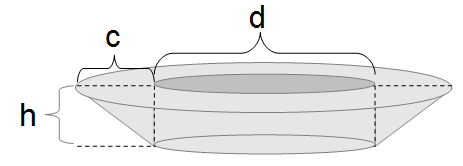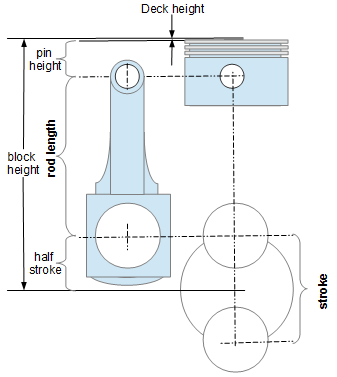The Cylinder Compression Volume calculator computes compression volume (V2) of the cylinder at the bottom of the stroke when the volume is at a minimum and is also known as the Clearance Volume and the Combustion Chamber volume. The Compression Volume is a function the piston chamber volume, deck volume, compression gasket volume, dish volume, dome volume, valve relief volume, crevice volume, and chamfer volume.  Chamfer
Chamfer
 Crevice
Crevice
 Gasket
Gasket
 Deck Height
Deck Height
INSTRUCTIONS: Choose your units (default is cubic inches) and enter the following:
- (cV) This is the chamber volume of the piston and the largest portion of the Compression Volume,
- (dV) This is the deck volume
- (cgV) This is the compression gasket volume
- (dishV) This is the dish volume (usually published in the cylinder specs)
- (domV) This is the dome volume (usually published in the cylinder specs)
- (vrV) This is the valve relief volume
- (crvV) This is the cylinder crevice volume
- (chmfV) This is the cylinder chamfer volume
Compression Volume: The calculator computes the Compression Volume in cubic inches. However, this can be automatically converted to other volume units (e.g. cubic centimeters or liters) via the pull-down menu. Note, a piston has either a dome or a dish, not both. Also note that the crevice and chamfer volumes have a default of zero since they are often ignored
Combustion Engine Calculators
Ratios and Lengths
- Cylinder Bore Diameter: Computes the diameter (bore) based on the engine displacement, number of cylinders and the stroke length.
- Bore Stroke Ratio
: Computes ratio based on the diameter of the bore and the length of the stroke.
- Combustion Ratio: Computes ratio base on the minimum and maximum displacements of the cylinder at the beginning (1-Induction) and compressed (3-Power) portions of the combustion cycle
- Displacement Ratio: Computes ratio based on the volumes at the beginning and end of the stroke.
- Rod and Stroke Length Ratio: Computes ratio base on the rod and stroke lengths.
- Stroke Length: Computes the required stroke length based on the total engine displacement, number of cylinders and the bore.
- Piston Position: Computes the piston position based on the crank angle, crank radius, and rod length.
- Piston Deck Height: Computes deck height based on Block Height, Rod Length, Stroke Length, and Pin Height.
Volumes and Displacements
- Total Volume (displacement) of a Combustion Engine: Computes volume based on the bore, stroke and number of cylinders.
- Volume (displacement) of a Engine Cylinder: Computes volume based on the bore and stroke.
- Volume (displacement) of an Engine with an Overbore: Computes volume based on the stroke, bore, overbore and number of cylinders.
- Equivalent Volume of a Rotary Engine: Estimates rotary engine volume based on the swept volume and number of pistons.
- Compressed Volume of a Cylinder:
Compute volume when the piston is at the end of the stroke and the chamber is at its smallest (and most compressed) volume, based on the chamber, deck, crevice, chamfer, gasket, valve relief and dome/dish volumes. This is the second volume (V2) in the Compression Ratio calculation.
- Volume of a Gasket: Computes gasket volume (displacement) based on the inner and outer diameters and the gasket's thickness.
- Volume of a Cylinder Deck: Computes the deck volume based on the deck height and the bore.
- Volume of a Cylinder Crevice: Computes crevice volume based on the piston diameter, cylinder bore and the crevice height.
- Volume of a Cylinder Chamfer: Computes chamfer volume based on the cylinder diameter and the chamfer height and width.
- Clearance Volume of a Piston: Computes the volume remaining in the combustion chamber when the piston is at its top dead center (TDC) which is the space above the piston crown when it's at its highest point in the cylinder.
- Engine Compression Ratio: Computes the ratio of the volume of the combustion chamber with the piston at its bottom dead center (BDC) to the volume with the piston at its top dead center (TDC).
Speeds and RPMs
- Piston Speed (mean): Computes the mean (average) piston speed based on stroke length and RPMs.
- Max Piston Speed: Computes max speed based on stroke length and RPMs
- RPMs: Computes revolutions per minute based on piston speed and stroke length.
Other Automotive Calculators
- Camber Angle
- Camber Offset
- Breakover angle - Ground clearance between axles
- Approach angle - Ground clearance in front of or behind vehicle.
- Belt Length
- Belt Speed.
- Pulley RPMs
- 2nd Pulley RPMs
- 2nd Pulley Diameter
- RPM of 4th pulley on three shafts
- 2nd Gear RPM
